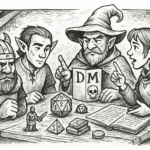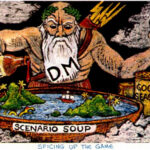⚠️ Check out the A Comprehensive Role-Playing Game Encounter Guide for an overview of how this feature of the game works.
Monsters react to adventurers not just through instinct, but also based on their past experiences and the rumors that spread about the party. This system combines your party’s reputation and charisma bonus to influence how monsters initially perceive them. Positive reactions can lead to more interesting encounters beyond just combat. A skilled Dungeon Master can use these reactions to create engaging situations. Remember, most creatures don’t want to die! A fierce party might scare off weaker monsters or force them to surrender, though truly powerful creatures might be harder to deter.
How it Works:
- Monster Reaction Chart: As usual, roll a d20 to determine the monster’s initial reaction using a Monster Reaction Chart.
- Reputation Modifier: Add the party’s average reputation score (rounded up) to the d20 roll. A good reputation makes a positive reaction more likely, while a bad reputation makes them more wary or aggressive.
- Charisma Bonus: Finally, add the party’s average Charisma bonus (rounded up) to the adjusted d20 roll. This reflects the party’s ability to use their presence and words to influence the encounter.
- Final Reaction: Consult the Monster Reaction Chart with the final adjusted total. This determines the monster’s initial reaction and any further actions or rolls needed.
Example:
A party with an average reputation of +2 and an average Charisma bonus of +1 encounters a monster. The Dungeon Master rolls a 15 on the d20.
- Adjusted Roll: 15 (d20) + 2 (Reputation) + 1 (Charisma) = 18
- Final Reaction: The DM consults the Monster Reaction Chart for a total of 18. This will guide the monster’s initial behavior based on the chart’s entry for 18.
| Roll (d20) | Reaction | Secondary Reaction |
|
1-3 | Immediately Attack | |
|
4-9 | Possible Attack, Roll Again: | |
|
1-10 | Attack! | |
|
11-15 | Negotiate | |
|
16-20 | Friendly | |
|
10-15 | Uncertain Attack, Roll Again: | |
|
1-6 | Attack! | |
|
7-13 | Negotiate | |
|
14-20 | Friendly | |
|
16-19 | Possible Friendly, Roll Again: | |
|
1-5 | Attack! | |
|
6-10 | Negotiate | |
|
11-20 | Friendly | |
|
20 | Immediately Friendly |
Negotiation
Uncertain monsters may try to talk or Negotiate. If they can communicate somehow, through words or hand motions, the monsters may suggest that some sort of agreement be made. This process of making offers and discussing them is called Negotiation. Reactions can make the game much more fun than having fights. With some careful thought, a good DM can keep everyone interested and challenged by the situations that can arise. Remember that no creature wants to get killed, and if the party looks or acts fierce, many creatures can be scared away or forced to surrender, although large and tough monsters probably won’t scare very easily.
Example: a monster might fear the party, and offer to pay them if they will go away!
Example: In exchange for its friendship, a hungry creature might ask for food. (A hungry animal might lick its lips, obviously hungry but apparently not wanting to attack the characters.)
Example: A more intelligent monster might want a bribe, threatening to attack unless the characters give it something.
How monsters and NPCs react differs based on their alignment. Some people and monsters cannot be trusted.
Example: A Chaotic monster will not necessarily keep its promises! Chaotics are not dependable. There are many Chaotic monsters.
Example: A Neutral monster will usually keep its word, especially if it could be risky to break it. It will do what is best for itself. More monsters are Neutral than either of the other Alignments.
Example: A Lawful monster will always do what it has promised; its word is as good as a written contract. However, there are very few Lawful monsters.
This Post Has 6 Comments
Leave a Reply
You must be logged in to post a comment.







Hey, just stumbled across this site and I like it’s the way you’ve cut down the 5e rules! Feels like a nice balance between OSR-type games and a more streamlined, modern experience. I’m not keen on the hundreds of class features and special resources in 5e, but I DO like the streamlined “proficiency bonus” based on level and similar ideas.
Anyway,I decided to comment because I wanted to say that this table in particular strikes me as quite odd.
Firstly, being split into two rolls makes it hard to work out the likelyhood of reactions at a glace – I had to do some maths on this:
(a=attack,n=negotiate,f=friendly)
15%a
30% any, split as so: 50%a, 25%n, 25%f – equiv to. 15%a, 7.5%n, 7.5%f on main chart
30% any, split as so: 30%a, 35%n, 35%f – equiv to. 9%a, 10.5%n, 10.5%f on main chart
20% any, split as so: 25%a, 25%n, 50%f – equiv to. 5%a, 5%n ,10%f on main chart
5%f
added up that gives the following chances:
15+15+9+5 = 44% attack
7.5+10.5+5 = 23% negotiate
5+7.5+10.5+10 = 33% friendly
So I guess this interacts with some other rules, and I’ve not read them all so maybe there’s a good reason, but I don’t see why this isn’t just one table that goes:
1-9 (45%) Attack
10-14 (25%) Negotiate
15-20 (30%) Friendly
I doubt the 1-3% difference would be noticeable and it saves you an unnecessary roll. Also, it strike me as strange that “negotiate” is the least common result, but that might be person preference.
Oh, just realized it says COMBINED charisma bonus – so I’m guessing the reason for banding is so as not to rule out the “attack” option entirely, even for very high charisma parties? I really wish there was a nicer way to handle attributes that adjust a roll on a table so that low results don’t drop off entirely, as I have a strong dislike for sub-tables.
I agree. If you have a better suggestion we’d love to hear it
Yes. Alignments in monsters are to help the Dungeon Master play the monster. Characters are supposed to be heroes.
Keep in mind you could run an evil campaign where all players ARE evil. Just another fun twist.
Yes. You should ALWAYS use the reaction chart when doing an encounter.